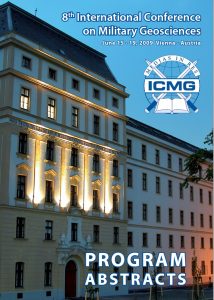Vienna, Austria
The following summary of the 2009 IMCG was written by Col (Ret’d) Ted Rose FInstRE, and published in the Winter 2009 edition of the The Ranger, the Journal of the Defence Surveyors’ Association (DSA). It is reproduced here with the kind permission of the DSA.
The 8th ICMG was held at the Austrian National Defence Academy, in Vienna, from 15-19 June 2009: convened by the Institute for Military Geography of the Austrian Armed Forces (led by Brigadier Reinhard Mang) and the University of Vienna Department of Environmental Geosciences (represented by Professor Hermann Hausler, a colonel in the Austrian reserve army). The 9th is being planned for 2011: to be held in the USA, at Las Vegas, convened by Dr Eric McDonald of the Desert Research Institute, with support from the US Army Research Office.
This series has evolved both in name and style. The first meeting, in Seattle, USA, in 1994, was intended as a one-off one-day symposium, convened under the auspices of the Geological Society of America. However, its success led to a similar meeting in the UK, in 1996, under the auspices of the Geological Society of London. A half-day meeting in Toronto, Canada, in 1998, was back again under the auspices of the Geological Society of America. Each of these generated post-conference books, published by the respective geological societies (Underwood & Guth, 1998; Rose & Nathanail, 2000; Ehlen & Harmon, 2001).
In 2000, in the UK, the scope broadened from geology to terrain, attracting contributions from geographers and historians as well as geologists, and expanding to a three-day ‘conference’, sponsored by the University of Greenwich in association with the Imperial War Museum and the Royal Engineers Museum. The conferences adopted the title ‘international’ and expanded to four days in 2003, when the next was hosted again in the USA, at the US Military Academy, West Point, with an explicit geography and geology theme. Numbering was adopted with the 6th conference, convened at the University of Nottingham in the UK in 2005. The broader scope of these three conferences is reflected in the books they generated (Doyle & Bennett, 2002; Caldwell et al., 2004; Nathanail et al., 2008). The 7th conference was held at the Universite Laval in Quebec, Canada, in 2007, and its book is currently in preparation (Ed. This volume was never completed).
With meetings thus alternating every couple of years between North America and Europe, in 2009 it was Europe’s turn – and ‘geology and geography’ became embraced in ‘geosciences’. A detailed analysis of previous conference books (Hausler, 2009) published to set the meeting in context revealed, inter alia, that although so far overall more first authors of published contributions came from the USA than elsewhere, surprisingly the three most prolific first authors all currently live in the UK.

The Vienna conference was the most ambitious so far, its programme extending over five days: four days of lectures plus a couple of half-day excursions, punctuated by a spectacular whole-day excursion in the middle. It was splendidly resourced by a team of 26 people, mostly drawn from the Austrian Institute for Military Geography but a few also from universities (of Vienna and Salzburg) and the Geological Survey of Austria: 5 to staff the organizing committee, 4 the daily information desk, 7 the excursions, 2 the poster sessions, 6 to provide technical and publication support, and 2 to function backstage. Many of these contributed oral and/or poster sessions during the conference, which attracted 57 additional registrants, most (as typically) from the host nation (21 from Austria); many (17), also typically, from the USA; 10 (an atypically large number) from Germany; 3 from the UK; and 1 each from Belgium, Canada, Croatia, France, South Africa and Syria.
First authors from the USA (17), Austria (11), Germany (7), UK (3), Canada (2) and France (2) generated in total 42 oral presentations. First authors from Austria (10), the USA (4), and Croatia, France, South Africa and the UK (I each) generated 18 poster presentations. Together the USA and Austria led with a total of 21 presentations each. But add the 7 German presentations to the 21 from Austria and it is clear that the conference provided a uniquely significant insight into past and present terrain expertise generated by armed forces using the German language – almost invariably presented in excellent English. The British contingent was small and exclusively academic, the American larger and military as well as academic. Impressively, groups of uniformed officers from the German and Austrian armies were led throughout the conference by officers of one-star rank. Coffee/lunch/tea breaks provided ample opportunities for networking.
Oral presentations were grouped into major themes: e.g. theory of military geosciences, climate change and geohazards, and military mapping and surveying. Papers on military geosciences in general formed the core component of three sessions, and war in mountain (Alpine) regions another two. In scope papers ranged from the historical, and lessons learnt, to the application of state-ofthe- art techniques.
The two keynote addresses were of particular significance: one by Colonel (Ret’d) Dr Werner Gillessen, who had led the former East Germany’s Military Topographic Service at the end of the Cold War, the other by Colonel (Ret’d) Dr Ulrich Barner, who had led West Germany’s Military Geographic Service at this time. Co-eval German cartography both east and west of the Iron Curtain could thus be compared and contrasted in lively discussion.
The programme was structured to provide a full day of presentations on the opening Monday and on Thursday, starting at 08.00. Tuesday and Friday had similarly early starts, but concluded with lunch, followed by a half day guided excursion: on one day to see some of the historical sites of Vienna, including the Globe Museum with its unique display indicating developments in understanding of global geography through time, on the other day to visit the Museum of Military History, whose extensive displays relating to the 1914-1918 and earlier wars were particularly impressive. Wednesday was the longest day but devoted entirely to a choice of field excursions into the Alps. Some participants chose the excursion by coach: to the Semmerling area, to examine sites of confrontation between German and Soviet forces in World War II – and the fall of the Iron Curtain in 1989. Most (about 40) chose the airborne alternative: flights by small aircraft and/or Blackhawk helicopter across much of southern Austria to demonstrate the main geological zones of this part of the Alps; visit to a World War I museum and cemetery near the Austrian/Italian border; and long flight east along the border to view former front line positions from the air, before continuing across the southern Eastern Alps back to the airfield near Vienna. The registration fee for the 5-day conference was a pricey €250, but from this trip, the excellent cooked lunches with generous allowance of wine/beer every day, and the wealth of publications freely distributed on and after registration, my impression is that everyone thought they received good value for their money.
The conveners of the 9th conference thus have a hard act to follow. However, the provisional theme of ‘desert warfare’ and proximity to terrain eminently suitable for field trips are likely to maintain the enthusiasm evident in this conference series so far. And by then, the conveners of the Vienna conference hope to have edited a selection of its peer-reviewed papers into a worthy book, potentially in the style adopted for their recent military geographical handbook (Mang & Hausler, 2006).
(Editor: A copy of the conference programme and abstract summary may be downloaded here – LINK)
References
Caldwell, D.R., Ehlen, J. & Harmon, R.S. (eds) 2004. Studies in military geography and geology. Kluwer Academic Publishers, Dordrecht.
Doyle, P. & Bennett, M.R. (eds) 2002. Fields of battle: terrain in military history. Kluwer Academic Publishers, Dordrecht.
Ehlen, J. & Harmon, R.S. (eds) 2001. The environmental legacy of military operations. Reviews in Engineering Geology XIV. Geological Society of America, Boulder, CO.
Hausler, H. 2009. Report on national and international military geo-conferences held from 1994 to 2007. MILGEO Nr. 30 E. Institut fur Militarisches Geowesen, Vienna.
Mang, R. & Hausler, H. (eds) 2006. International handbook: military geography. Ministry of Defence, Vienna.
Nathanail, C.P., Abrahart, R.J. & Bradshaw, R.P. (eds) 2008. Military geography and geology: history and technology. Land Quality Press, Nottingham.
Rose, E.P.F. & Nathanail, C.P. (eds) 2000. Geology and warfare: examples of the influence of terrain and geologists on military operations. Geological Society, London.
Underwood, J.R., Jr. & Guth, P.L. (eds) 1998. Military geology in war and peace. Reviews in Engineering Geology XIII. Geological Society of America, Boulder, CO.
